Hello,
The user guide is rather terse about it.
With the Notion3 drum set sounds the keyboard keys usually assigned to the drum sounds (C1 and above) do not work.
By groping, I found the right keys between F3 and B4, which is quite unusual : if you want to assign a third-part VSTi the sounds are no more consistent.
How do you manage that ?
Tkx
- It is currently Tue Apr 23, 2024 2:25 am • All times are UTC - 5 hours [ DST ]
Attention:
Welcome to the old forum. While it is no longer updated, there is a wealth of information here that you may search and learn from.
To partake in the current forum discussion, please visit https://forums.presonus.com
Writing the drum staff
8 posts
• Page 1 of 1
Re: Writing the drum staff
Zblogny wrote:How do you manage that ?
STRATEGY
The strategy here in the sound isolation studio is based on (a) selecting a subset of drumkits, as well as Indian and Latin percussion instrument collections, and then (b) using them exclusively, unless there is a specific percussion instrument or sound that I need but is not available in any of the standard percussion libraries that I use . . .
Rather than remembering which notes map to specific drums, cymbals, and so forth, I move the notes upward and downward on the staff until I hear the correct sound, at which time I work on the rhythm pattern for the particular drum, cymbal, or percussion instrument, where the key to the strategy is that I put each percussion instrument on a separate staff, where it nearly always is a single-note type of thing, where only the notes for the specific drum, cymbal, or percussion instrument are on its corresponding staff . . .
[NOTE: With multiple voices, it is possible to have four parts on the same staff when the VSTi instrument and sample library support multiple voices, but it is too visually busy, so the only thing I do occasionally is to play two or three percussion notes simultaneously as if they were a simple triad or chord . . . ]
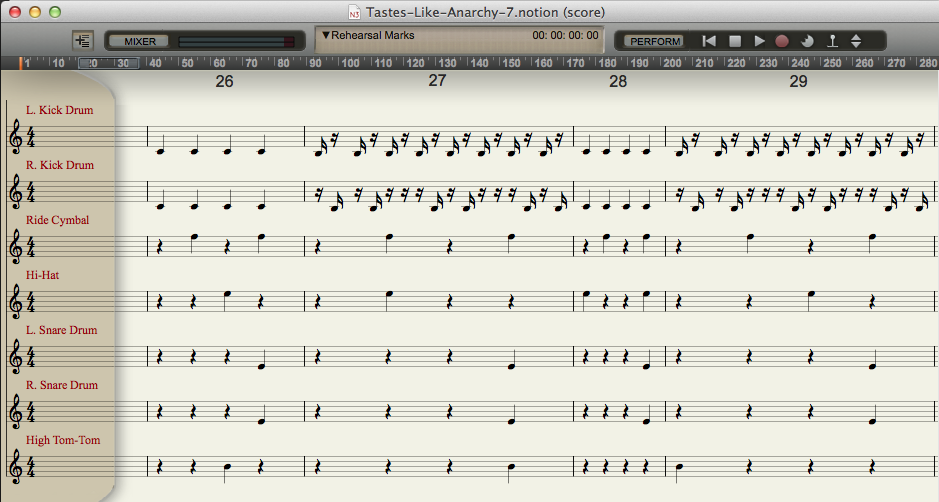
The advantage of having each drum, cymbal, and Indian or Latin percussion instrument on a separate staff at the primitive one-note-at-a-time level is that I can save NOTION 3 scores of drumkit phrases and use them to define custom templates, as well as to use them as a type of database for purposes of copying and pasting standard drumkit and percussion stuff, where the copying and pasting is done by opening a NOTION 3 drumkit score when there already is a primary NOTION 3 score opened, at which time I can copy phrases from the drumkit score to the primary score, with the only practical consideration being that the number of "heavy" VSTI virtual instruments needs to be within the limits of what NOTION 3 can handle, which typically is approximately 20 to 25 "heavy" VSTi instruments in the primary score and perhaps an additional 5 or so "heavy" VSTi virtual instruments for the drumkit and percussion score, where yet another basic rule is that every VSTi virtual instrument is "heavy" . . .
I usually do the drums, cymbals, and other percussion instruments in pairs, although for some instruments I spread them over as many as eight (8) staves, since I like to "sparkle" instruments, which is the name of the technique that I devised for using music notation and the NOTION 3 Mixer to put the individual notes of an instrument into motion across the "rainbow panning arc", which is easy to do since the NOTION 3 Mixer has true stereo panning controls . . .
In other words, I focus on defining rhythm patterns for the particular drums, cymbals, and percussion instruments that I use most frequently, and in many instances a rhythm pattern for a specific instrument can be modified quickly for use with another instrument, since most of the rhythm patterns I create and save for copying and pasting are just a few measures, although there might be as many as eight (8) staves . . .
For example, two (2) measures of a fully "sparkled" instrument where the unit is eighth notes maps to 16 eighth notes spread over eight (8) staves for two (2) measures, and it does not take much time to adjust the notes upward or downward to change the drum, cymbal, or other percussion instrument, as shown in the following image of two (2) measures of fully "sparkled" maracas and cowbell in "Tastes Like Anarchy" (The Surf Whammys), which is fabulous . . .
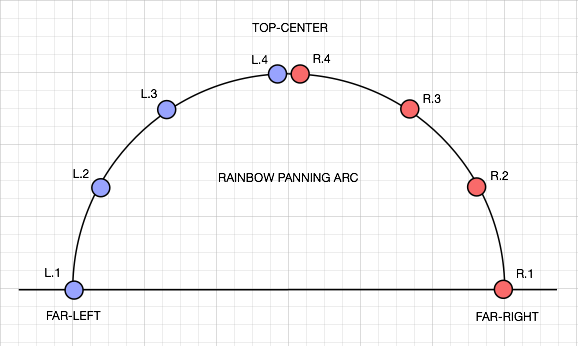
[NOTE: I have two general strategies for the way I name instruments when I am creating templates and database scores for various purposes, and one strategy is to use specific names like {"L. Kick Drum", "R. Kick Drum"}, but the other strategy is to use a general name, as is the case in the following example for "sparkling" maracas and cymbals, which works because it is done via SampleTank 2.5 XL, hence I call it a "Synth" and can use it for any instrument or sound that is available for use with SampleTank. If I forget which instrument it represents and plays, then I can select a few of the notes and preview them, or I can switch to the NOTION 3 Mixer and click on the name of the staff, which launches the standalone user interface for SampleTank 2.5 XL, at which time I can double-click on the name of the preset, which reveals the specific sample sound library selection in the details pane, which maps to not needing to remember which note maps to a particular drum, cymbal, percussion instrument, or any other type of instrument, which is good, because there are thousands and thousands of instruments, which is too much for me to remember, although since I have an eidetic memory for sounds I tend to remember the overall details for specific collections of drums, cymbals, and percussion instruments, which is useful for high-level navigating purposes . . . ]
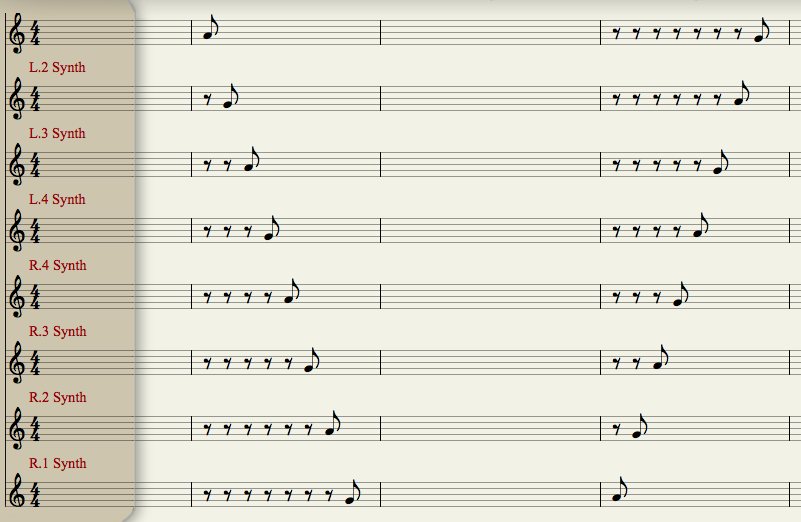

[NOTE: If you listen with headphones, you will hear the maracas and cowbell notes move from far-left to far-right and then back to far-left, which is an example of "sparkling", as are the double kick drums and the snare drum rimshots . . . ]
"Tastes Like Anarchy" (The Surf Whammys) -- Basic Rhythm Section -- MP3 (8.5MB, 302-kbps [VBR], approximately 3 minutes and 53 seconds)
Fabulous!
BACKGROUND, DETAILS, TIPS
Before discovering NOTION 3 and VSTi virtual instruments I did all the drumkit and Latin percussion stuff with real instruments, which worked reasonably well until I decided to do a Flamenco song in a modified Bulería style and realized that it was vastly impractical for me to attempt to do the elaborate percussion stuff myself, which curiously was the motivation that led me to discover VSTi virtual instruments and NOTION 3 via Miroslav Philharmonik (IK Multimedia) . . .
Soon thereafter, I discovered that while I was reasonably proficient with treble clef music notation for most instruments, as well as singing, this was not the case for percussion instruments and drumkits in particular, when led to a few months of working diligently to learn how to do syncopated rhythm patterns for drums and cymbals, during which time I got more information about VSTi virtual drumkit sample libraries and soon settled on SampleTank (IK Multimedia), where in particular I like the "Studio Tight" drumkit in the "Studio Natural" library, although I also like the Indian style drums and percussion instruments in the Xpansion Tank 2 (IK Multimedia) "World Instruments Collection" of multi-sampled instruments . . .
SampleTank FREE (IK Multimedia)
More recently, I have expanded my collection of VSTi virtual instruments and sampled sound libraries to include Kontakt 5 (Native Instruments), and Addictive Drums (XLN Audio), where there is a free version of Addictive Drums, which is quite nice for DISCO and Pop songs . . .
[NOTE: I have the full version of everything, except for Addictive Drums, which is on the list of things to get, sooner or later, although at present I am more focused on getting Saturn, FabFilter Software Instruments newly released VST saturation effects plug-in, which I think will be an excellent addition to the vintage signal processing VST effects plug-ins that come with T-RackS 3.5 Deluxe (IK Multimedia) specifically for mastering work . . . ]
Kontakt 5 Player FREE (Native Instruments)

Addictive Drums FREE (XLN Audio)

Saturn (FabFilter Software Instruments)
[NOTE: IK Multimedia is having a "Group Buy" extravaganza and discount promotion on T-RackS 3.5 Deluxe until the end of March 2012, where it is vastly discounted, which makes this an excellent time to get it if you do not already have it, since one of the realities of digital music production is that you need both a calibrated full-range studio monitor system and mastering software . . . ]
T-RackS 3.5 Deluxe (IK Multimedia)
Lots of FUN!
P. S. The eidetic memory thing is a bit selective here in the sound isolation studio, where it is focused on being able to map sounds and phrases to songs rather than being something which would be useful if one were playing "Name That Song", but so what . . .
So what!
For example, I notice and remember detailed stuff like the Instrumental Surf guitar lines being nearly identical in "Livin' La Vida Loca" (Ricky Martin) and "Aserejé" (Las Ketchup), which is fabulous . . .
"Livin' La Vida Loca" (Ricky Martin) -- YouTube music video
"Aserejé" (Las Ketchup) -- HD Spanglish Version -- YouTube music video
Fabulous!
-
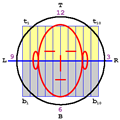
Surfwhammy - Posts: 1137
- Joined: Thu Oct 14, 2010 4:45 am
Re: Writing the drum staff
Thank you Surfwhammy for your -as usual- very detailed reply, but it does not answer my simple question.
So I'll try to rephrase it more clearly :
Suppose I load a Jazz combo template.
I write the drum part in the dedicated drum staff.
The Notion3 sound for that drum part does not suit me.
So I assign another VSTi to that staff with VST manager.
And my drum staff no longer works...
I don't mind create as many staves as instruments of my drum kit, I just want my Notion3 drum staff plays my chosen drum kit...
Is it possible or not ?
So I'll try to rephrase it more clearly :
Suppose I load a Jazz combo template.
I write the drum part in the dedicated drum staff.
The Notion3 sound for that drum part does not suit me.
So I assign another VSTi to that staff with VST manager.
And my drum staff no longer works...
I don't mind create as many staves as instruments of my drum kit, I just want my Notion3 drum staff plays my chosen drum kit...
Is it possible or not ?
-
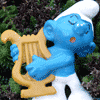
Zblogny - Posts: 97
- Joined: Fri Dec 17, 2010 2:18 pm
Re: Writing the drum staff
Zblogny wrote:Thank you Surfwhammy for your -as usual- very detailed reply, but it does not answer my simple question.
So I'll try to rephrase it more clearly :
Suppose I load a Jazz combo template.
I write the drum part in the dedicated drum staff.
The Notion3 sound for that drum part does not suit me.
So I assign another VSTi to that staff with VST manager.
And my drum staff no longer works...
I don't mind create as many staves as instruments of my drum kit, I just want my Notion3 drum staff plays my chosen drum kit...
Is it possible or not ?
Hi!
This is unfortunately not possible unless you can modify your drum plugin and reassign the different drum parts to the keys that Notion uses.
I use BFD a lot and I had to make a "Notion" map in the BFD plugin i.e. reassign the keys played for different parts of the drum set.
My music http://www.musikboden.se
-

ulrik - Posts: 203
- Joined: Thu Feb 04, 2010 5:27 am
- Location: Sweden
Re: Writing the drum staff
Zblogny wrote:Is it possible or not ?
Based on my experience, either (a) probably not or (b) not easily . . .
On the other hand, if there is a way to specify the mapping of specific notes to drums via rules, then there might be a way to do it, but even then there will be variations, since as best as I can determine the specific mappings of notes to drums and cymbals varies even among drumkits in the same sample library . . .
[NOTE: At least in theory, there should be a way to determine the MIDI rules for everything, but I did a bit of research on MIDI and was not very happy with what I found. For example, NOTION 3 is considered to be a "MIDI Editor", but it is not what I consider to be MIDI editor in the way software engineers use the term "editor". Using an example, UltraEdit is a hexadecimal editor that one can use to examine raw data, which if you know the structure of application binaries and other stuff can be very useful. More specifically, I would like to have a MIDI editor that can read a MIDI file and then translate the information in the MIDI file into MIDI commands, instructions, and so forth, but I was not able to find one for the Mac, although there might be one available for Windows. The last time I checked the MIDI specification, it was not available in electronic or digital format, although it is available in printed format. If you really want to make sense of MIDI, then knowing the specification of MIDI files is very important, and like application programs there are specific formats for files, although application programs typically of obfuscated to make it more difficult for people to decode them. Yet, I can export a NOTION 3 staff as MIDI and then import the MIDI file to Reason 5, where the notes are played correctly, so there is a specific format for MIDI files. Another example is SQLite database files, which have a specific structure, and if you know the structure, then you can examine the data; modify the structure; update the data; and so forth and so on, where RazorSQL (Richardson Software, LLC) is a personal favorite. Based on the research I have done so far, my impression is that making sense of low-level MIDI is not something that a lot of people do, at least to level where there is a market for what I consider to be a low-level MIDI file editor, which also applies to the internal format for a NOTION 3 score, which is something I would really like to know or at least to have some type of Software Development Kit (SDK) and Application Programming Interface (API), which is something I explained in the topic on NOTION 4 that I created last year or sometime. I like the way that Apple does iTunes, Mac Apps, and iOS Apps, since while Apple exercises high-level control, the infrastructure allows participation by folks who create content music and motion pictures to applications and data to books, magazines, and newspapers. The intriguing aspect for NOTION is that with an SDK and API, it becomes possible to have third-party products which extend and enhance NOTION. It also is an excellent way to "own" a market, where the key is exercise sufficient high-level control to ensure a consistent user experience. There are other ways to do this, and I am pondering some of them, but I prefer the model where Notion Music provides an SDK and API for NOTION, along with a Notion Music App Store or whatever one might want to call it, because there is a lot of stuff that can be done to make composing in the NOTION framework vastly more productive, at least for the genres of modern popular music, since using the Beatles as an example, there are not so many different drumkit, bass, guitar, and keyboard phrases, because as "play by ear" folks understand intimately, by the time you learn the first few albums of Beatles songs note for note, you can play any Beatles songs with a little bit of work, which is the case for nearly every musical group four decades later at the dawn of the early-21st century. For reference, the way I do things probably is a bit different, because I play instruments "by ear", but I compose songs in NOTION 3 using music notation, and these are two essentially different skills, since for example (a) I can play a drumkit part in real-time on a drumkit; (b) I can compose a drumkit part using music notation and a VSTi virtual drumkit in NOTION 3; but (c) going from one to the other currently is not one of the skills here in the sound isolation studio, hence what saves me a lot of time is having a catalog or library of drumkit phrases in music notation. And the high-level perspective is that at least for DISCO and Pop songs everything is so standard or whatever that having to do music notation one note at a time is a bit archaic, although it works and is vastly superior to not being able to do it any other way. Explained another way, again using the Beatles as an example, the fact of the matter is that Paul McCartney does not have a vast repertoire of electric bass phrases, and Ringo Starr does not have a vast repertoire of drumkit phrases, which basically is the case for every musician in modern popular musical genres, where as a general rule by the time you learn perhaps 50 songs note-for-note or at least near enough for a nightclub audience to rate you as being "really good" or whatever, then there you are, and you know the pattern and playing style for the instrument specific to a particular musical group, which is what "play by ear" musicians learn how to do at a very early age without having any idea how it maps to music theory, music notation, mathematics, geometry, acoustic physics, perceptual psychology, and so forth and so on. Even more specifically, the potential to do a lot of this stuff via music notation and VSTi virtual instruments in NOTION is what makes NOTION so amazing as a complete foundation or framework, which is what it is, and while it is a bit odd to be able to compose a song using music notation but not to be able to play the song by reading the music notation, so what, because if I actually need to be able to play the electric guitar part for one of my songs, then I can listen to it a while and learn how to play it "by ear", and I do not envision this changing conceptually any time soon, which is fine with me, since the highly detailed and elaborate mappings I have developed over the years are very useful, and they work for what I need to do, which travels with the general perspective that it is better for them to be generally separate and independent mappings, since in the same way that a reasonably intelligent person can learn how to touch-type, this also is the case with music theory and music notation, but this is not the case with "play by ear", which is something that can be developed and enhanced but basically is an "either or" type of thing, hence is something that I protect diligently, since my perspective is that it is a fundamentally intrinsic ability, which if present can be developed and enhanced but if not present is unlikely to occur, or at least will not occur easily in an intuitive way . . . ]
RazorSQL (Richardson Software, LLC)
[NOTE: At some point, I plan to order all the MIDI documentation, but not for a while, although it is on the list of things to do. It would be nice if everything was available in digital format, but I learned how to make sense of virtual festivals of printed software engineering documentation long before there were PDF files and personal computers, and it appears that the worst case on the complete set of printed documentation is that it costs perhaps $200 (US) or thereabout . . . ]
MIDI Technical Specifications & Information (MIDI Manufacturers Association)
[NOTE: Continued in the next post . . . ]
-

Surfwhammy - Posts: 1137
- Joined: Thu Oct 14, 2010 4:45 am
Re: Writing the drum staff
[NOTE: Continued from the previous post . . . ]
For the type of songs I currently am doing, I use the "Studio Tight" drumkit samples from SampleTank 2.5 XL (IK Multimedia), but sometimes I augment them with one of the Indian percussion samples, mostly (a) to get more tom-tom types of drums and (b) to get the tympani type of pitch variation on attack and release that is more typical of Indian percussion . . .
And after experimenting with different drumkits, the perspective I have is that there is no standard for mapping notes to specific drums, cymbals, Latin percussion, and so forth . . .
Hence my focus on what one might call the "workaround" aspect, which is a key part of the strategy here in the sound isolation studio, which is based on an odd type of laziness, where the general idea is to define a complete system that avoids having a lot of variables or at least minimizes the variables which cannot be avoided . . .
In other words, there are a lot of things that I would like to be possible, but within the specific framework of digital music production using NOTION 3, Reason, Digital Performer, ReWire, and a virtual festival of VST effects plug-ins and VSTi virtual instruments my focus is on defining everything in sufficient detail so that there are not so many variables that doing songs becomes too complex for it to be practical . . .
From a practical perspective, I do not need 50 drummers and 1,000 drumkits, which makes a bit of sense when you consider it from the perspective of a real musical group . . .
I need a good drummer who has a drumkit that sounds good, and this is the strategy I use to provide a practical solution for the drumkit stuff, where the drummer and drumkit combination I like is heard in the following basic rhythm section for one of the Surf Whammys songs I am developing for the "Electric Underpants" album, which is fabulous . . .
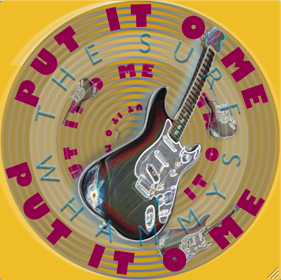
[NOTE: This is a headphone mix, and for reference it is the Surf Whammys response to "Hold It Against Me" (Britney Spears), which specifically was necessary to reintroduce a bit of order in the universe due to the chaos created by a particularly mind-boggling lyrical phrase in Britney's song, which to be specific is, "'Cause you feel like paradise, and I need a vacation tonight" . . . ]
"Put It O Me" (The Surf Whammys) -- Basic Rhythm Section -- MP3 (8.2MB, 301-kbps [VBR], approximately 3 minutes and 33 seconds)
Fabulous!
From yet another perspective, I think that it is more important at present to focus on discovering how to make everything sound good, since the music, lyrics, and instrumental stuff is coming along nicely, hence my focus on providing a practical solution for a calibrated full-range loudspeaker studio monitor system, which in turn is the prerequisite for being able to mix and master accurately, all of which is coming along nicely, although for reference none of the example mixes I have done so far are done with the final version of the calibrated full-range loudspeaker studio monitor system . . .
Lots of FUN!
P. S. There is another perspective on this, and it is very important for composers, musicians, and singers to understand, since as best as I can determine it is something that none of them, including me, generally consider in any intuitive way . . .
What happens is that composers, musicians, and singers who are reasonably proficient tend to presume that arranging, producing, mixing, and mastering are trivial activities which can be done entirely based on intuition, which nearly never is the way it works . . .
Once you realize this and embark on an elaborate quest to make sense of the stuff that, for example, George Martin and the audio engineers at Abbey Road Studios did for the Beatles, sooner or later you discover the vastly annoying fact that there are no full-range commercial off the shelf (COTS) studio monitor systems on this planet, which with a bit of sua sponte serendipity then leads one to discover that there are two types of listeners or "hearers" in the world, where one type are fundamental tone hearers and the other type of overtone hearers, with the key difference being that fundamental tone hearers are not fooled by the "Missing Fundamental" auditory illusion, hence require a calibrated full-range studio monitor system, all of which is explained in one of my ongoing project topics in the IK Multimedia FORUM . . .
Missing Fundamental Auditory Illusion (wikipedia)
[NOTE: The simple audio test created by the researchers at Heidelberg University for determining whether one is a fundamental tone hearer or an overtone hearer is found at the following link to the Hydrogenaudio FORUM . . . ]
How Do You Hear Tones? (Hydrogenaudio FORUM)
The Fabulous Affordable Studio Monitor System Project (IK Multimedia FORUM)
The connection to the original question is that when correctly mixed and mastered, a song using the NOTION 3 bundled instruments and add-on instrument libraries is quite likely to sound the way you want it to sound, thereby making discovering a way to do VSTi virtual instrument mappings to the Notion Music instrument libraries a bit moot, although it depends on what you need and your ability to manipulate the way instruments sound with VST effects plug-ins and other stuff . . .
For all practical purposes, I discovered how to play a few key instruments proficiently nearly half a century ago, and the only significant change since then is that I discovered (a) how to compose stuff in real-time on the fly and (b) how to compose and play textures rather than notes, which for the most part is like discovering how to turn the "Tone" control on a Fender Custom Shop Dual Professional electric guitar amplifier to 11 . . .
Yet, the songs I did in the digital music production universe seven years ago sound terrible, although at the time I thought they sounded great, which is where the arranging, producing, mixing, and mastering stuff comes into play, which is easy to observe by listening to a song I did seven years ago and then listening to the songs I am doing now, where the primary difference is the arranging, producing, mixing, and mastering, which is coming along nicely . . .
In other words, you can be a perfect choirboy, but nothing is going to work well until there is a choirmaster, which is the role George Martin played for the Beatles . . .
Explained another way, you need to determine whether you are (a) a fundamental tone hearer or (b) an overtone hearer, and if you are a fundamental tone hearer, then you can arrange, produce, mix, and master your own songs, but this requires a calibrated full-range studio monitor system which has big woofers and can handle sound pressure levels (SPL) in the range of 80 dB SPL to 85 dB SPL at least some of the time, which in turn requires calibrating equipment and an SPL Meter, since listening with headphones will not work, where for reference "full-range" maps to 20-Hz to 20,000-Hz and is the range of normal human hearing, for sure . . .
For sure!
For the type of songs I currently am doing, I use the "Studio Tight" drumkit samples from SampleTank 2.5 XL (IK Multimedia), but sometimes I augment them with one of the Indian percussion samples, mostly (a) to get more tom-tom types of drums and (b) to get the tympani type of pitch variation on attack and release that is more typical of Indian percussion . . .
And after experimenting with different drumkits, the perspective I have is that there is no standard for mapping notes to specific drums, cymbals, Latin percussion, and so forth . . .
Hence my focus on what one might call the "workaround" aspect, which is a key part of the strategy here in the sound isolation studio, which is based on an odd type of laziness, where the general idea is to define a complete system that avoids having a lot of variables or at least minimizes the variables which cannot be avoided . . .
In other words, there are a lot of things that I would like to be possible, but within the specific framework of digital music production using NOTION 3, Reason, Digital Performer, ReWire, and a virtual festival of VST effects plug-ins and VSTi virtual instruments my focus is on defining everything in sufficient detail so that there are not so many variables that doing songs becomes too complex for it to be practical . . .
From a practical perspective, I do not need 50 drummers and 1,000 drumkits, which makes a bit of sense when you consider it from the perspective of a real musical group . . .
I need a good drummer who has a drumkit that sounds good, and this is the strategy I use to provide a practical solution for the drumkit stuff, where the drummer and drumkit combination I like is heard in the following basic rhythm section for one of the Surf Whammys songs I am developing for the "Electric Underpants" album, which is fabulous . . .

[NOTE: This is a headphone mix, and for reference it is the Surf Whammys response to "Hold It Against Me" (Britney Spears), which specifically was necessary to reintroduce a bit of order in the universe due to the chaos created by a particularly mind-boggling lyrical phrase in Britney's song, which to be specific is, "'Cause you feel like paradise, and I need a vacation tonight" . . . ]
"Put It O Me" (The Surf Whammys) -- Basic Rhythm Section -- MP3 (8.2MB, 301-kbps [VBR], approximately 3 minutes and 33 seconds)
Fabulous!
From yet another perspective, I think that it is more important at present to focus on discovering how to make everything sound good, since the music, lyrics, and instrumental stuff is coming along nicely, hence my focus on providing a practical solution for a calibrated full-range loudspeaker studio monitor system, which in turn is the prerequisite for being able to mix and master accurately, all of which is coming along nicely, although for reference none of the example mixes I have done so far are done with the final version of the calibrated full-range loudspeaker studio monitor system . . .
Lots of FUN!
P. S. There is another perspective on this, and it is very important for composers, musicians, and singers to understand, since as best as I can determine it is something that none of them, including me, generally consider in any intuitive way . . .
What happens is that composers, musicians, and singers who are reasonably proficient tend to presume that arranging, producing, mixing, and mastering are trivial activities which can be done entirely based on intuition, which nearly never is the way it works . . .
Once you realize this and embark on an elaborate quest to make sense of the stuff that, for example, George Martin and the audio engineers at Abbey Road Studios did for the Beatles, sooner or later you discover the vastly annoying fact that there are no full-range commercial off the shelf (COTS) studio monitor systems on this planet, which with a bit of sua sponte serendipity then leads one to discover that there are two types of listeners or "hearers" in the world, where one type are fundamental tone hearers and the other type of overtone hearers, with the key difference being that fundamental tone hearers are not fooled by the "Missing Fundamental" auditory illusion, hence require a calibrated full-range studio monitor system, all of which is explained in one of my ongoing project topics in the IK Multimedia FORUM . . .
Missing Fundamental Auditory Illusion (wikipedia)
[NOTE: The simple audio test created by the researchers at Heidelberg University for determining whether one is a fundamental tone hearer or an overtone hearer is found at the following link to the Hydrogenaudio FORUM . . . ]
How Do You Hear Tones? (Hydrogenaudio FORUM)
The Fabulous Affordable Studio Monitor System Project (IK Multimedia FORUM)
The connection to the original question is that when correctly mixed and mastered, a song using the NOTION 3 bundled instruments and add-on instrument libraries is quite likely to sound the way you want it to sound, thereby making discovering a way to do VSTi virtual instrument mappings to the Notion Music instrument libraries a bit moot, although it depends on what you need and your ability to manipulate the way instruments sound with VST effects plug-ins and other stuff . . .
For all practical purposes, I discovered how to play a few key instruments proficiently nearly half a century ago, and the only significant change since then is that I discovered (a) how to compose stuff in real-time on the fly and (b) how to compose and play textures rather than notes, which for the most part is like discovering how to turn the "Tone" control on a Fender Custom Shop Dual Professional electric guitar amplifier to 11 . . .
Yet, the songs I did in the digital music production universe seven years ago sound terrible, although at the time I thought they sounded great, which is where the arranging, producing, mixing, and mastering stuff comes into play, which is easy to observe by listening to a song I did seven years ago and then listening to the songs I am doing now, where the primary difference is the arranging, producing, mixing, and mastering, which is coming along nicely . . .
In other words, you can be a perfect choirboy, but nothing is going to work well until there is a choirmaster, which is the role George Martin played for the Beatles . . .
Explained another way, you need to determine whether you are (a) a fundamental tone hearer or (b) an overtone hearer, and if you are a fundamental tone hearer, then you can arrange, produce, mix, and master your own songs, but this requires a calibrated full-range studio monitor system which has big woofers and can handle sound pressure levels (SPL) in the range of 80 dB SPL to 85 dB SPL at least some of the time, which in turn requires calibrating equipment and an SPL Meter, since listening with headphones will not work, where for reference "full-range" maps to 20-Hz to 20,000-Hz and is the range of normal human hearing, for sure . . .
For sure!
-

Surfwhammy - Posts: 1137
- Joined: Thu Oct 14, 2010 4:45 am
Re: Writing the drum staff
Zblogny wrote:Hello,
The user guide is rather terse about it.
With the Notion3 drum set sounds the keyboard keys usually assigned to the drum sounds (C1 and above) do not work.
By groping, I found the right keys between F3 and B4, which is quite unusual : if you want to assign a third-part VSTi the sounds are no more consistent.
How do you manage that ?
Tkx
I use the transposition settings for the staff line in the "score setup" mode to push the drum staff into whatever range best suits the drums vsti instrument I want to notate, sort of like you would normally do for a transposing instrument but instead just making the range of the staff fit the range of your drums' midi notes.
-

dgriffee - Posts: 114
- Joined: Sun Oct 04, 2009 10:09 pm
Re: Writing the drum staff
dgriffee wrote:I use the transposition settings for the staff line in the "score setup" mode to push the drum staff into whatever range best suits the drums vsti instrument I want to notate, sort of like you would normally do for a transposing instrument but instead just making the range of the staff fit the range of your drums' midi notes.
This is one of my most favorite things about NOTION 3, for sure . . .
For sure!
THOUGHTS AND OBSERVATIONS
I learned how to sight-read treble clef when I was in a liturgical boys choir and was a soprano, hence soprano treble clef is very easy and intuitive for me, but since there was no practical reason to learn other clefs at the time, all I learned was soprano treble clef, which is fine with me, since the other clefs are vastly confusing and make no sense from my perspective . . .
Toward the end of my liturgical boys choir experience, I discovered that girls were quite fascinating and then switched to focusing on Rock and Roll, since I also discovered that girls like Rock and Roll, with the key bit of information from the perspective of music being that I abandoned music notation and focused on the "play by ear" strategy, since there was no immediately available sheet music for Rock and Roll songs when they first started getting radio play, hence I learned the parts by listening to records at slower or faster speeds and then identifying notes one at a time, which is a useful skill in many respects . . .
The reality here in the sound isolation studio is that "play by ear" works very nicely for me, but while I am a reasonably good drummer there are limits to what I can do on drums without a lot of practicing, hence the "lazy" strategy of doing drumming via VSTi virtual instruments and music notation in NOTION 3 . . .
[NOTE: Drums are not one of my primary instruments, and the reason I started playing drums was to be able to record all the parts for songs, which was before I knew anything about VSTi virtual instruments and NOTION 3, although if I worked on kick drum foot pedal stuff intensely for a few months--10 hours a day or thereabout--I would be a great drummer . . . ]
Doing a bit of dot-connecting and realizing that there is a merit to the adage about not being able to teach an old dog new tricks, I only use the soprano treble clef, but I modify the register or octave for the way the notes on the treble clef are played, hence for me everything is soprano treble clef visually in NOTION 3, which makes the music notation work virtually trivial, since yet another reality is that someone can hand me a sheet of Classical music, and I can look at the soprano part for a few seconds and then sight-sing it with good accuracy, although the singing sounds more like Brian Wilson on a bad day, which is more along the lines of the "ladies" auxiliary in Monty Python sketches, but so what . . .
So what!
And while in many respects I am vastly smart, this travels with a bit of occasional stupidity or naivety in terms of not noticing things in an immediately conscious way that other people notice instantly, where one example is that I made no significant progress when I was teaching myself how to play lead guitar until I had the epiphany that as a general rule every lead guitar solo recorded since Thomas Edison invented the first recording device was played by a lead guitarist who had four fingers and a thumb on each hand, although there were a few guitar players who had an extra finger, although not so many, really . . .
Really!
Another example is that I did not realize in an immediately conscious way until approximately two years ago that I am a baritone, which was a huge epiphany here in the sound isolation studio and mapped to a vast improvement in my singing . . .
In other words, the ability to use the soprano treble clef in NOTION 3 for everything is stellar, and it fits nicely with the mathematical and geometric system I developed when I taught myself how to play electric bass and electric guitar "by ear", which specifically is that once I learn the primitive mathematical and geometrical pattern for chords, melodies, and musical phrases, I can play them in any key by moving upward or downward on the fretboard, which in turn makes it abundantly obvious that there actually are only 12 notes, where the differences are that each note can appear in one or more of 8 octaves, which is a perfect fit for the way one can define the soprano treble clef in NOTION 3, since (a) there are two octaves on the soprano treble clef when you allow a few notes above and below the staff and (b) you can set the register for actually playing the notes from two octaves lower to two octaves higher, which covers all the notes on a grand piano and is a very logical mathematical and geometrical mapping . . .
And to keep everything as simple as possible, I do all the music notation in the default key of C and the default time signature of 4/4, which includes avoiding the nonsense of having multiple names for what really is one note and maps to keeping the use of flats and sharps to a minimum, where for example I avoid the ambiguity introduced by allowing "G♯" and "A♭", preferring instead to call the note "G♯", where the only reason I use flats at all is the direct consequence of a complete and total failure in my ongoing efforts to avoid being in musical groups with horn players--specifically trumpet players, who for some unknown reason demand that songs be played in E♭, F, or B♭, which (a) are a terrible keys for electric bass and electric guitar and (b) are even worse for piano and keyboard synthesizers, since it requires using the vastly awkward and confusing black keys . . .
On the other hand, devising a simply way to make horn players "happy" when I was playing electric bass in nightclubs in junior high school led to discovering the mathematical and geometrical pattern stuff, which later led to discovering Barre chords when I started playing electric guitar, so it actually was a good thing to be in musical groups with horn sections, at least of for a while . . .
SUMMARY
There is great merit (a) to having exactly one name for each note on a grand piano and (b) to being able to use the soprano treble clef, 1 key, and 1 time signature for everything in NOTION 3, which is stellar from a mathematical and geometrical perspective, as is conceptualizing music in terms of there being 12 notes and 8 octaves, since this allows everything but keeps it as simple and mathematically elegant as possible, which is fabulous . . .
Fabulous!
-

Surfwhammy - Posts: 1137
- Joined: Thu Oct 14, 2010 4:45 am
8 posts
• Page 1 of 1
Who is online
Users browsing this forum: No registered users and 43 guests